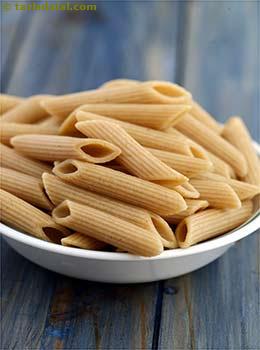" Enjoy whole wheat pasta with broccoli, bell peppers, red onions, parsley, olives and spice it up with mixed herbs.
" The robust shape will hold up well under chunky meat and vegetable sauces.
" The pasta is also palatable plain, with a light sprinkling of olive oil and fresh herbs.
" In addition to being served with sauce, whole wheat pasta can be baked in casseroles, added to pasta salad, and included in soups.
" Serve with simple mixed greens and sprouts. Sprouts benefit assimilation of nutrients because their fats, proteins and starches have been broken down into easily digestible forms. Adding parsley also helps to improve the digestion of fats in most meals.
" These served with flavourful sauces or layered with cheese and vegetables are very lip-smacking.
" Keep in mind that some whole-wheat pastas seem to lighten in color as they cook.
" Add mayo, sour cream, and lemon juice to a 1-cup measure and stir to blend
How to store whole wheat pasta, wholemeal pasta, gehun ke atte ka pasta
Store it, unopened, in a cool, dry cupboard for six to eight months or as per the expiry date. Dried, fresh, and cooked pasta need to be stored in different ways. Fresh pasta will keep for 1-2 days in the refrigerator and can also be frozen. Stuffed pasta or fresh pasta made with eggs will keep for 1 day in the refrigerator or 2 months in the freezer. Cooked pasta will keep for 3-5 days in the fridge or freezer. When refrigerating or freezing cooked pasta, be sure it is stored in a well sealed container so that it does not absorb any odors.
Health benefits of whole wheat pasta, wholemeal pasta, gehun ke atte ka pasta
Whole wheat pasta is slightly low in calories and carbs than refined pasta. What it has to offer is more
fibre and some nutrients which many other pasta are devoid of. Thus whole wheat pasta made with loads of veggies minus the cheese is a wise choice for
weight watchers and
heart patients.
Diabetics can also enjoy the pasta as mentioned above, but they need to restrict their portion size strictly. However, remember that whole grain pasta is not similar to whole grains. It is yet processed and will not have the same effect on blood sugar and cholesterol levels. Hence we recommend the use of whole wheat pasta only occasionally.
Cooked whole wheat pasta

Boil plenty of water in a large pan with 1 tsp of salt and 1 tsp of oil.
Add the whole wheat pasta to the boiling water by adding a few at a time. Cook uncovered, stirring occasionally and gently until the pasta is tender. Cooking times may vary with the size and the thickness of the pasta. Immediately drain the cooked pasta into a sieve or a colander. Transfer to a bowl of cold water to refresh it. Drain again and keep aside.If the pasta is not to be used immediately, add 1 tbsp of oil to it and toss it.